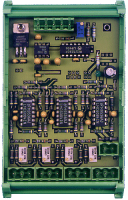PT100V4

Pt100 sensors demand more conditioning effort than other sensors as the resistance change over temperature is very small. The problem gets worse with distance: the resistance of the cable adds to the signal resistance with the effect of wrong results. Pt100V4 amplifies the sensor signal and compensates cable effects.
- Sensor conditioning module for Pt100 RTDs.
- Four instrumentation amplifier inputs for Pt100 sensors.
- 3-wire-connection to compensate for cable resistance.
- Four 0..5V voltage outputs to NET/900H, TSM-CPU, TSM-8AD8, TSM-8AD12 or any other 0..5V analog inputs.
- -50..205°C standard temperature range.
- Prices
- Details
Details
Pt100V4 produces a reference current of about 1mA to result in a voltage change over the sensor resistance. This voltage is amplified to give a 5V span over the desired temperature range. A common way to account for long cables is the 3-wire-connection. This allows to measure the voltage over the shorted line resistance in comparison to the voltage over the sensor resistance. Substracting these voltages results in a signal voltage that is independent of cable resistance. Pt100V4 works with 3-wire technology. The typical accuracy at a module temperature of 25°C is ±0,3°C. It requires 18..24V auxiliary voltage.
Although Pt100V4 looks like a TSM module, the TSM-CPU cannot directly read the module but requires 4 analog inputs. Pt100V4 has a 5-pin-screw terminal block to connect the conditioned 0..5V outputs to an analog input.
Technical data:
- Size: 74x126mm
- Current consumption 40mA at 24V
- Connectors needed: 5x MVSTBR2,5-3/ST-5,08; 2x MVSTBR2,5-2/ST-5,08


